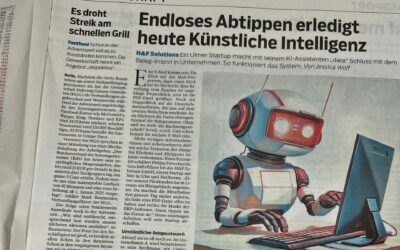Stone-age document exchange: Why RPA, OCR and EDI are only bridging solutions.

FOCUS ON DOCUMENT EXCHANGE
Every year, 1.2 trillion documents are exchanged between companies.
Only an average of 15% of these are automatically transferred from one ERP system to another via EDI.
But why is that? The answer is clear: the exchange of documents still requires considerable manual effort as well as extensive technical integrations if two companies want to cooperate as trading partners.
When exchanging orders that require precise processing in the system, the IT departments of both companies are faced with extensive tasks:
An agreement on the format for transmitting the order data is required.
The data must be correctly assigned within this format.
Due to the system’s susceptibility to errors, manual intervention by specialist personnel is essential for corrections.
In view of these challenges, the implementation of alternative technologies for further automation could be considered. However, this approach often encounters obstacles, such as an already busy IT department and other prioritized software projects. This prioritization leads to a lack of available resources for setting up additional EDI connections, as such projects prove to be particularly time-consuming, especially in scenarios where there is a high level of data variance.
This is exactly what Intelligent Data Interchange (IDI) is.
“OCR, RPA or EDI – we already have solutions to process our documents automatically.”

In the business world, many companies are already using technologies such as OCR (Optical Character Recognition), RPA (Robotic Process Automation) and EDI (Electronic Data Interchange) to improve the exchange of documents. Although these solutions can increase efficiency and productivity in the area of document exchange to a certain extent, they inevitably reach their individual limits. This means that such solutions are merely stone-age interim solutions on the way to complete automation.
With
OCR
based systems can identify and extract data well, but additional manual adjustment is often required to adequately assign the data to the intended integration system and there is no automatic feedback regarding data quality or the presence of all necessary information.
RPA
based technologies take over routine, rule-based tasks through “bots”, but many ERP providers are skeptical about the use of RPA technologies and adapt their forms dynamically, which makes it difficult to adequately process the results.
EDI
based systems enable the exchange of documents in a standardized electronic format, but high investments and challenges in standardization can limit scalability.
In view of these aspects, it is crucial that companies develop a long-term strategy for the automation of document exchange that goes beyond temporary solutions and enables a sustainable increase in efficiency.
A truly intelligent and scalable solution is characterized by the fact that it not only identifies existing data, but also recognizes data gaps and automatically supplements them with the correct information. It no longer relies exclusively on the synchronicity of master data, but adapts flexibly to a certain degree of individuality on the part of the user parties.
This is exactly what Intelligent Data Interchange (IDI) is.
Intelligent Data Interchange (IDI) systems offer innovative solutions for traditional challenges.

Intelligent Data Interchange (IDI) refers to data exchange in which machine learning and artificial intelligence play a key role. This makes it possible to overcome data barriers in a largely autonomous and self-learning manner by means of corresponding established mechanisms.
What does the use of Intelligent Data Interchange actually look like?
Our cloud solution dara® uses intelligent data exchange and…
…ensures a degree of automation of up to 99% in document processing.
… proactively identifies decisive moments for human intervention, provides default values and learns continuously.
…contextualizes information and can thus assign it correctly.
…identifies, corrects and enriches existing data independently and thus closes data gaps with high data quality.
…ensures quick and easy onboarding of new business partners and efficient management of existing business relationships.
…no longer relies exclusively on the synchronization of master data, but adapts to a certain degree of individuality brought in by the user parties.
…contributes to time and resource savings thanks to the high degree of automation.
The added value generated represents an enormous enrichment for companies, because…
…overloaded IT departments are often the reason why new business and thus new interfaces cannot be realized quickly enough.
… IT teams are no longer burdened with lengthy business partner onboarding processes. Instead, they can focus their resources on more productive and forward-looking projects, turning them from a bottleneck into a driving factor for scaling the company.
…compact and reliable data formats not only contribute to environmental sustainability, but also improve traceability and ensure comprehensive transparency within the supply chain. This is becoming increasingly important, particularly with regard to statutory audits.
…enabling a significant increase in scalability for organizations by effortlessly adapting to business growth and changing business requirements.
Together for automation: How a community can change document transfer.

In the current business world, every company acts as a lone fighter when it comes to connecting new business partners. However, effective cooperation requires comprehensive clarification of the individual characteristics and particularities of each party. This involves careful coordination of the format in which order data is to be transmitted, followed by precise mapping of the data within this format. Imagine, however, if this entire process were obsolete – a scenario in which connecting business partners could be done effortlessly and without the previous effort.
Intelligent Data Interchange systems represent an optimal solution in this context, as they can serve companies as a sound knowledge base, because…
… the system is able to learn continuously through interaction with network participants and to acquire the specific characteristics of individual partners.
… as soon as a new participant joins the network who already has the same partner as a customer, there is no need for further training, as the system is already familiar with the specific requirements of this partner.
Through this effect, the entire community benefits collectively from corresponding learning processes and the entire community.
Exchange ?
Become part of this year’s IDI conference now: https://www.eventbrite.de/e/idi-conference-tickets-795943096227
Or become part of our IDI community on LinkedIn:
https://www.linkedin.com/groups/12895906/
#document exchange #data exchange #data flow #document exchange #EDI #nextlevelEDI #IDI #OCR #RPA


